
a web page by Don Roberson |
 |
PETRELS, SHEARWATERS & ALLIES Procellariidae |
||||
|
||||
Perhaps it is awe for their incredible transequatorial migrations, knowing that a bird seen in the Gulf of Alaska was nesting in the Southern Hemisphere just a month or so before. Buller's Shearwater (left and below left ; the latter with Pink-footed Shearwaters) nests in New Zealand and then undertakes a great clockwise migration around the north Pacific, reaching Monterey Bay (as in this photo) every August-September. There is feeds on the rich resources brought to the surface by deep-water upwelling. Buller's mix with Pink-footed Shearwater (below left), a species whose primary breeding grounds are in the Juan Fernandez Islands off the west coast of Chile. And here to is Sooty Shearwater (below right) — up to half-a-million in season — in the midst of a huge figure-8 migration route that averages 64,000 km [=40,000 miles] annually. These data are from miniaturized archival tags that tracked Sooty Shearwaters from New Zealand breeding grounds to feeding areas off Japan, Alaska, and California in what the researchers called an integration of "oceanic resources across the Pacific Ocean in an endless summer" (Shaffer et al. 2006). This is the longest animal migration ever tracked. At times a shearwater traveled up to 620 miles (1000 km) a day. |
||||
|
||||
 |
||||
  Yet
another reason to be fascinated by procellarids is that we (usually)
must venture away from our land habitat into the open ocean to observe
them. We rarely see them well from a constantly moving boat. But at
certain sea-watching points huge numbers of procellarids can be seen
from shore. One of those is Pt. Pinos at the tip of the Monterey
Peninsula, just a few blocks from my home (two photos above right). The
photo above the sea-watchers shows a dozen Black-vented Shearwater
headed west, past Pt. Pinos, on a windy day in December. During my 1.5
hour of sea-watching they were passing by at the rate of at least
100/minute, or 9000 in that short period. Eleven species of the
Procellariidae have been observed from Pt. Pinos, including 3 vagrant Pterodroma (Cook's, Hawaiian, and Mottled). Yet
another reason to be fascinated by procellarids is that we (usually)
must venture away from our land habitat into the open ocean to observe
them. We rarely see them well from a constantly moving boat. But at
certain sea-watching points huge numbers of procellarids can be seen
from shore. One of those is Pt. Pinos at the tip of the Monterey
Peninsula, just a few blocks from my home (two photos above right). The
photo above the sea-watchers shows a dozen Black-vented Shearwater
headed west, past Pt. Pinos, on a windy day in December. During my 1.5
hour of sea-watching they were passing by at the rate of at least
100/minute, or 9000 in that short period. Eleven species of the
Procellariidae have been observed from Pt. Pinos, including 3 vagrant Pterodroma (Cook's, Hawaiian, and Mottled). |
||||
Yet another aspect of procellarids that makes them fascinating is that a fair number are difficult to identify at sea, and there has been a progression of knowledge in recent years as one after another seemingly intractable problem is worked out. I even had a hand in sorting out the identification issues in the small black-and-white shearwaters (Roberson 1996) and in the the seven tiny Pterodroma petrels in the tropical Pacific collectively known as the 'Cookilaria' petrels (Roberson & Bailey 1991). During four months at sea as a seabird researcher about the USS MacArthur on a NOAA tuna-porpoise research cruise in fall 1989, I gained firsthand experience with five of the 'Cookilaria.' On my return I received a Chapman grant to travel to the American Museum of Natural History in New York to examine collection, take measurements (below left; measuring the bill of a Cook's Petrel specimen), and working with Keith Hansen in his i.d. plate for publication (below right). |
||||
|
||||
|
||||
There are two species of Giant Petrel on earth: this one, set against the snowy landscape of South Georgia Island, is Southern Giant-Petrel (lovely shot by Greg W. Lasley during an Antarctic cruise). Many of the breeding island for petrels and shearwaters are difficult to reach.
|
||||
There are six species of prions — plus the tiny Blue Petrel Halobaena caerulea — that pose challenges for those on Antarctic and sub-Antarctic cruises. Fairy Prion (left) may be encountered on a New Zealand pelagic trip. It is found farther north than most. |
||||
|
||||
| My Haurake Gulf pelagic also had a Common Diving-Petrel (above left). Until very recently, the four species of diving-petrels were assigned to a separate family, the Pelecanoididae. In the massive molecular review by Prum et al. (2015), using multiple nuclear and mtDNA introns, it was shown that the diving-petrels in genus Pelecanoides are embedded within the phylogeny of the petrels and shearwaters. Thus the old "family" must now be merged into the Procellariidae. There are two circumpolar species, one in the sub-Antarctic and another in more temperate (but still quite cold) southern waters (this is the Common Diving-Petrel of New Zealand and Tasmania, shown above left). The other two species are from South America, including Peruvian Diving-Petrel (above right). All the diving-petrels resemble each other closely, and are separated on details of breadth and length of their stout bills, plus details of the distribution of whitish on underparts or face. Although diving-petrels are clearly in the Order Procellariiformes, having "tube-noses" as do albatrosses, shearwaters, and storm-petrels, most of the Procellariiformes are masters of the air, gliding for hours above the waves. Diving-petrels are better adapted for the sea. They have stocky bodies with short wings and thick necks, and fly with whirling wingbeats. In this they quite resemble the completely unrelated auks and relatives (Alcidae) of the northern hemisphere. This is a case of convergent evolution. They are agile swimmers and divers, even in the roughest of seas, and in this they again resemble the auks or penguins. Like alcids, they ride rather buoyantly on the water surface when not diving. Diving-petrels are generally found singly or in loose groups on the ocean, but they breed in dense colonies, mostly on offshore islands with only a few mainland colonies in protected areas. Nests are in burrows and, as with many colonial seabirds, they arrive and depart those burrows at night to avoid predators. Diving-petrels tend to feed inshore and rarely disperse far from the breeding colonies, although a few individuals have been encountered a fair distance offshore (Carboneras 1992). | ||||
Variation in Cory's Shearwater is also evident, and is related to specific island populations. The most common were "Atlantic" Cory's Shearwater C. d. borealis: a huge, hulking shearwater with white underwings but all-dark remiges (below left). A very few were slightly smaller birds with more buoyant flight and (often) a scaly back, and a different underwing pattern. The most prominent example was one that followed the boat (below right) with prominent white 'fingers' in the underwings, including the outermost primaries. This is the Mediterranean breeding "Scopoli's Shearwater" C. d. diomedea, sometimes considered a separate species; identification is discussed in Gutiérrez (1998) and Howell & Patteson (2008a). |
||||
|
||||
In the Atlantic Ocean, observers have just recently discovered that Fea's Petrel P. feae, Trindade Petrel P. arminjoniana (the Atlantic Ocean version of now-split Herald Petrel P. heraldica), and even the endangered Bermuda Petrel P. cahow may be regular in summer. Their identification has just recently been understood (Tove 1997, Wingate et al. 1998). Here's a Trindade Petrel (below) in a high arc over the Gulf Stream off North Carolina in May. |
||||
|
||||
While Cook's and Murphy's are southern petrels that get to the north Pacific regularly, others are vagrants. So fair it appears that Cape Petrel (below left) never gets north of the Galapagos but another large southern species, White-chinned Petrel (below right, photographed off South Africa) is a vagrant to both coasts of North America. This particular White-chinned Petrel has an unusual amount of white on the head. |
||||
|
||||
| Carboneras (1992) begins his discussion of this family by saying: "The taxonomy of the Procellariidae is extraordinarily complex, and it is consequently subject to frequent revisions, and more than its fair share of polemic." One example is the "Dark-rumped Petrels" now split as Galapagos Petrel (below left) and Hawaiian Petrel (below right, a superb shot by Peter J. Dunn). It took decades to split the two taxa into separate species, and another decade or so before observers accepted the fact that it was Hawaiian Petrel that occurs in offshore California. Peter Dunn's photo of Hawaiian Petrel is so dramatic because it shows the Pt. Pinos Lighthouse in the background! These Pterodroma are usually found only many miles offshore! | ||||
|
||||
The above pair of photos nicely illustrate difference between Galapagos Petrel (photo from the Galapagos) and Hawaiian Petrel (photo in California). Note the heavy bill and 'shawl' over the entire rear of the head on Galapagos Petrel. Hawaiian Petrel has a decidedly shorter, smaller bill and much reduced 'shawl' restricted to the rear of the crown, and set off by a white indentation behind the eye (see Force et al. 2005, Howell 2012). Another example of contention in taxonomy and identification is among the small black-and-white shearwaters in the genus Puffinus. Murphy (1952) lumped many around the world as "Manx Shearwater P. puffinus." This was well wide of the mark and the modern trend is to separate isolated island populations in different oceans as distinct species. But even then there remains debate: should Newell's Shearwater P. newelli in Hawaii be lumped with Townsend's Shearwater P. auricularis of the Revillagigedos Is., Mexico? Jehl (1982) argued they should be lumped (mostly on vocalizations) but most recent authors do not agree; see Howell et al. (1994), Howell (2015). The AOU did not spilt Townsend's and Newell's into two species until 2015. These taxonomic issues sometimes overshadow the truly impressive range expansion in the last half-century by the Manx Shearwater of the North Atlantic. Once restricted as a breeding species to islands off nw. Europe (Scotland, etc.) it first colonized northeastern North America and then began an explosion of vagrancy that took birds all the way to New Zealand and Australia (see Kinsky & Fowler 1973 for details of a bird banded in Britain being picked up in Australia). The first vagrants to the n.e. Pacific were in the late 1970s; by the 1990s Manx Shearwater had become a regular migrant and winterer in small numbers in Monterey Bay. They must be nesting somewhere around the Gulf of Alaska now as we see young birds in the fall ( more details in Roberson 1996). This is as impressive a range expansion as any species on earth! There are several good papers on the identification of Manx Shearwater; Howell et al. (1994), Roberson (1996). The two photos below from Monterey Bay show some classic Manx Shearwater features: sharply demarcated face pattern with an 'ear-surround' and white undertail coverts (below left, nice shot by Brian L. Sullivan), and on a bird going away (below right), the white flanks extend upwards to sides of rump. Note in both shots crisp blackish above/white below pattern and short-tailed appearance. |
||||
|
||||
|
I haven't even touched on breeding biology or foraging ecology. Many details are packed into Warham (1995) and summarized by Carboneras (1992). But I did want to mention the amazing interaction between some petrels and cetaceans. Juan Fernandez Petrels and Wedge-tailed Shearwaters are among the foraging seabirds regularly found around tuna-porpoise assemblages in the eastern tropical Pacific (see Au & Pitman 1986). My four months at sea in 1989 included studying these associations. |
||||
 |
||||
Even more specific and dramatic is evidence that the New Zealand breeding Parkinson's Petrel (above) consistently forages with pods of Melon-headed Whale Peponocephala electra and False Killer Whale Pseudorca crassidens in the tropical Pacific. Nearly two-thirds of all observations on multiple research cruises were in direct association with these two species (Pitman & Ballance 1992). On my cruise in fall 1989, I noticed that the few Phoenix Petrels seen were often associated with large cetaceans. Below is my shot of a Phoenix Petrel in the wake of an Orca (Killer Whale) way offshore in the eastern tropical Pacific. |
||||
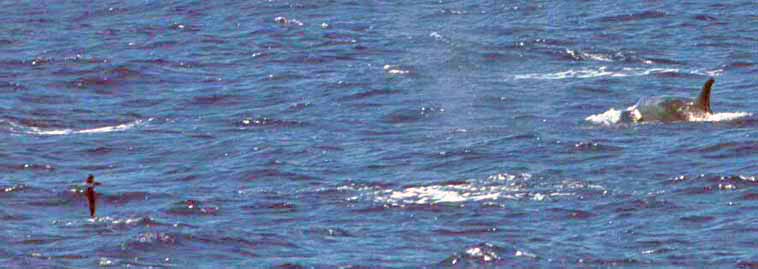 |
||||
Photos: The Murphy's Petrel Pterodroma ultima was well offshore central California on 11 Apr 1991. The Buller's Shearwater Ardenna bulleri was on Monterey Bay on 29 Oct 2011; the mixed flock of a Buller's and several Pink-footed Shearwater A. creatopus was there on 23 Sep 2012, and the Sooty Shearwater A. griseus was taken on 13 Sep 2014. The photo of 20 Black-vented Shearwater Puffinus opisthomelas passing Pt. Pinos, California, was taken 23 Dec 2015; the photos of birders watching seabirds from Pt Pinos were from Apr 2005 (left) and Nov 2015 (right). The Barau's Petrel Pterodroma baraui were at the St. Etienne R. mouth, Réunion I., Indian Ocean, on 9 Dec 1992. Although the Cook's Petrel Pterodroma cookii specimen illustrates the discussion of the AMNH research that led to the paper with Keith Hansen's fine painting, the actual specimen shown here is at California Academy of Science, San Francisco, and it represents the first specimen record for California (found ashore in Santa Cruz 17 Nov 1983; #CAS71447). The photos of Cook's Petrel at sea were in the Hauraki Gulf, New Zealand, on 14 Nov 2009, as were the shots of Fairy Prion Pachyptila turtur and Common Diving-Petrel Pelecanoides urinatrix. The Southern Giant-Petrel Macronectes giganteus was photographed by Greg W. Lasley off South Georgia I., South Atlantic Ocean, on 26 Jan 1999. The photo of Peruvian Diving-Petrel Pelecanoides gamotii was taken just off the Paracas Peninsula, Peru, from a small boat on 12 June 1987. The Black-capped Petrel Pterodroma hasitata was off Cape Hatteras, North Carolina, on 13 June 2009, as was the "Scopoli's" Cory's Shearwater Calonectris d. diomedea, and the Audubon's Shearwater Puffinus lherminirei; the photo of "Atlantic" Cory's Shearwater C. d. borealis: was taken the next day. The Trindade Petrel Pterodroma arminjoniana was off Cape Hatteras, North Carolina, on 26 May 2013; Murphy's Petrel P. ultima was off central California in April 1991. The Cape Petrel Daption capense was off Cape Town, South African, on 4 July 2005, as was the White-chinned Petrel Procellaria aequinoctialis. The Galapagos Petrel Pterodroma phaeopygia was between Isabella & Santa Cruz Is., Galapagos, on 23 Sep 1989. Peter J. Dunn photographed the Hawaiian Petrel Pterodroma sandwichensis from a boat just off Pt. Pinos, Monterey Co., California, on 25 Aug 2014. Brian L. Sullivan photographed the left-hand Manx Shearwater Puffinus puffinus on Monterey Bay, California, on 11 Sep 2011; the right-hand bird was there on 10 Oct 2015. The dark-morph Wedge-tailed Shearwater Ardenna pacifica was on Monterey Bay on 11 Oct 1998. The Parkinson's Petrel Procellaria parkinsoni was in the Hauraki Gulf, New Zealand, on 14 Nov 2009. The interaction between Phoenix Petrel Pterodroma alba and Orca Orcinus orca was at 7°30'N, 144°30'W, on 5 Sep 1989. Uncredited photos © Don Roberson. Credited photos © Greg W. Lasley, Peter J. Dunn, and Brian L. Sullivan as credited, and used with permission; all rights reserved. Bibliographic note:
Literature cited:
|
||||
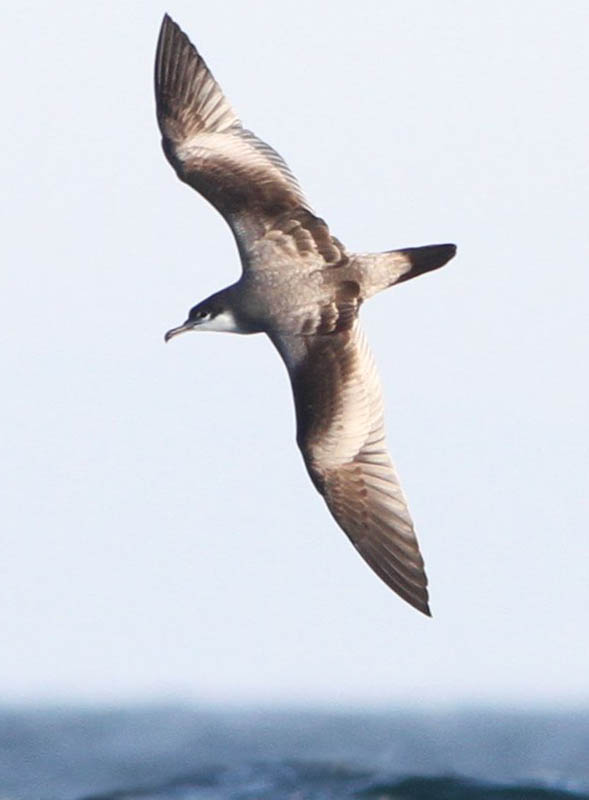 There
is just something about procellarids — the petrels, shearwaters, and
allies. Perhaps it is their gliding flight over the waves, covering
huge distances without apparent effort. Perhaps it is the apparent
mastery of the wildest winds and seas — a Pterodroma arcing over the horizon is the epitome of the untamed ocean realm and the classic seabird. An example is Murphy's Petrel (above), shown here a hundred miles off the California coast, arcing over the waves in a gale.
There
is just something about procellarids — the petrels, shearwaters, and
allies. Perhaps it is their gliding flight over the waves, covering
huge distances without apparent effort. Perhaps it is the apparent
mastery of the wildest winds and seas — a Pterodroma arcing over the horizon is the epitome of the untamed ocean realm and the classic seabird. An example is Murphy's Petrel (above), shown here a hundred miles off the California coast, arcing over the waves in a gale. 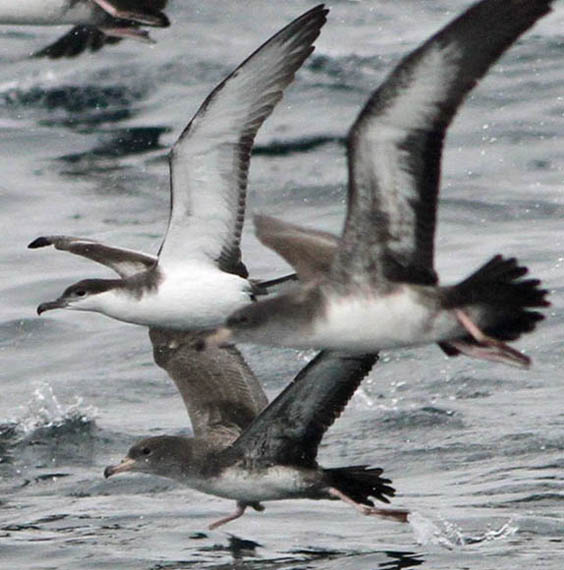
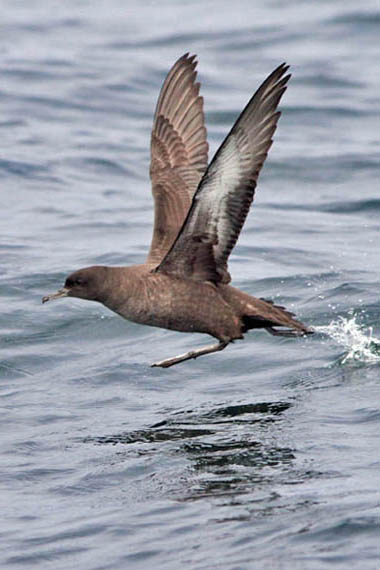
 Just about 30% of procellarids are shearwaters (genera Ardenna, Puffinus, Calonectris). Aside from a handful of prions, fulmars and giant-petrels, the majority are petrels in 8 genera. Some 32 species are Pterodroma petrels, the really far-out procellarids ranging thousands of miles offshore. In the Indian Ocean is Barau's Petrel
(right). Very little is known about its life at sea. It breeds only on
the Mascarene Islands; this adult is heading ashore on Réunion
I. late in the afternoon. Virtually all procellarids breed on offshore
islands, many of them using burrows or caves. Dogs, cats, rats, weasels
and the like are death of breeding adults and their young. Because
there are so few predator-free islands, procellarids have declined in
many places globally.
Just about 30% of procellarids are shearwaters (genera Ardenna, Puffinus, Calonectris). Aside from a handful of prions, fulmars and giant-petrels, the majority are petrels in 8 genera. Some 32 species are Pterodroma petrels, the really far-out procellarids ranging thousands of miles offshore. In the Indian Ocean is Barau's Petrel
(right). Very little is known about its life at sea. It breeds only on
the Mascarene Islands; this adult is heading ashore on Réunion
I. late in the afternoon. Virtually all procellarids breed on offshore
islands, many of them using burrows or caves. Dogs, cats, rats, weasels
and the like are death of breeding adults and their young. Because
there are so few predator-free islands, procellarids have declined in
many places globally. 



 As all my experience for writing about Pterodroma
petrels came from trips off California, and the eastern tropical
Pacific cruise, it was really nice to do a New Zealand pelagic trip in
2009 — and now with a digital camera! One could even take nice detailed
photos of Cook's Petrel (above left). And because we
encounter petrels almost always in the open ocean — out of sight of
land — is always dramatic to see a petrel flying toward a remote
breeding island. Here (above right), a Cook's heads towards Little
Barrier Island in the Haurake Gulf.
As all my experience for writing about Pterodroma
petrels came from trips off California, and the eastern tropical
Pacific cruise, it was really nice to do a New Zealand pelagic trip in
2009 — and now with a digital camera! One could even take nice detailed
photos of Cook's Petrel (above left). And because we
encounter petrels almost always in the open ocean — out of sight of
land — is always dramatic to see a petrel flying toward a remote
breeding island. Here (above right), a Cook's heads towards Little
Barrier Island in the Haurake Gulf. 


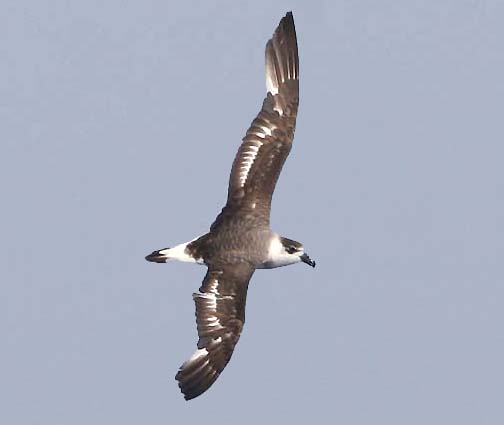 Perhaps the most desired offshore birds are Pterodroma petrels. Off the Atlantis coast of North America, the regular species is Black-capped Petrel
(left). Recently the fact that there are two "types" of Black-capped
Petrel has been publicized. "Light morph" types predominated, such as
the one at left with broad while collar, but there were some "dark" or
"intermediate" types (above) with dingy collars. This variation has
recently been quantified (Howell & Patteson 2008b) but it is not
known whether it is related to specific island populations.
Perhaps the most desired offshore birds are Pterodroma petrels. Off the Atlantis coast of North America, the regular species is Black-capped Petrel
(left). Recently the fact that there are two "types" of Black-capped
Petrel has been publicized. "Light morph" types predominated, such as
the one at left with broad while collar, but there were some "dark" or
"intermediate" types (above) with dingy collars. This variation has
recently been quantified (Howell & Patteson 2008b) but it is not
known whether it is related to specific island populations. 

 Another
reasonable common species off the eastern U.S. coast is Audubon's
Shearwater (right). It breeds in the Caribbean and ranges northward in
the Gulf Stream. In the Pacific, the populations in the Galapagos
Islands have recently been split as Galapagos Shearwater Puffinus subalaris.
Another
reasonable common species off the eastern U.S. coast is Audubon's
Shearwater (right). It breeds in the Caribbean and ranges northward in
the Gulf Stream. In the Pacific, the populations in the Galapagos
Islands have recently been split as Galapagos Shearwater Puffinus subalaris. 
 In the North Pacific we have learned in the past 25 years that Cook's Petrel and Murphy's Petrel P. ultima are apparently regular well offshore, that both Mottled P. inexpectata and Stejneger's P. longirostris
are likely regular in migration way out there (see McCaskie &
Roberson 1992 for details of the first record of the latter species),
and Great-winged Petrel P. macroptera visits on occasion.
Indeed, I found during a research cruise in April 1991 well offshore
between Pt. Sur to Pt. Año Nuevo, California, in very rough
weather, that Murphy's Petrel (left) was the commonest bird out there
beyond 50 miles offshore (at least that year).
In the North Pacific we have learned in the past 25 years that Cook's Petrel and Murphy's Petrel P. ultima are apparently regular well offshore, that both Mottled P. inexpectata and Stejneger's P. longirostris
are likely regular in migration way out there (see McCaskie &
Roberson 1992 for details of the first record of the latter species),
and Great-winged Petrel P. macroptera visits on occasion.
Indeed, I found during a research cruise in April 1991 well offshore
between Pt. Sur to Pt. Año Nuevo, California, in very rough
weather, that Murphy's Petrel (left) was the commonest bird out there
beyond 50 miles offshore (at least that year). 
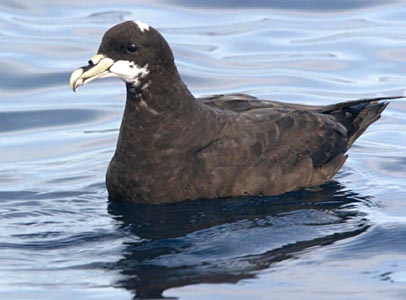
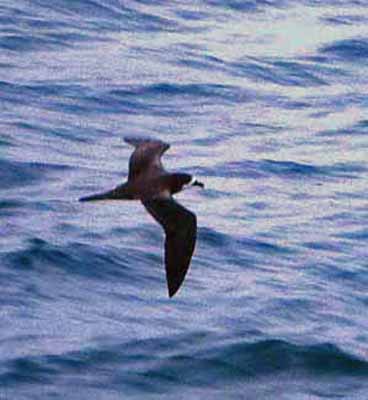



 The
influence of water temperature and salinity conditions on distribution
is important; some aspects for the northeast Pacific have been
summarized by Ainley (1976) and Briggs et al. (1987). Vagrancy among
procellarids is indeed impressive, and was recognized a few decades ago
by Bourne (1967); I co-authored a paper on the second state record of
Streaked Shearwater Calonectris leucomelas (Roberson et al.
1977) and California's first Wedge-tailed Shearwater (Stallcup et al.
1988). A substantial amount of wandering is influenced by conditions on
a global scale. El Niño-Southern Oscillation conditions greatly
impact bird distribution when they occur, and the "great" El
Niños (like 1982–1983 and 1997–1998) engender distant incursions
of warm water species, sometimes for years afterwards until a more
"typical" balance is restored. The occurrence of Wedge-tailed
Shearwater off California appears to be linked to El Niño; this
dark morph was in Monterey Bay for several weeks in October 1998
(right).
The
influence of water temperature and salinity conditions on distribution
is important; some aspects for the northeast Pacific have been
summarized by Ainley (1976) and Briggs et al. (1987). Vagrancy among
procellarids is indeed impressive, and was recognized a few decades ago
by Bourne (1967); I co-authored a paper on the second state record of
Streaked Shearwater Calonectris leucomelas (Roberson et al.
1977) and California's first Wedge-tailed Shearwater (Stallcup et al.
1988). A substantial amount of wandering is influenced by conditions on
a global scale. El Niño-Southern Oscillation conditions greatly
impact bird distribution when they occur, and the "great" El
Niños (like 1982–1983 and 1997–1998) engender distant incursions
of warm water species, sometimes for years afterwards until a more
"typical" balance is restored. The occurrence of Wedge-tailed
Shearwater off California appears to be linked to El Niño; this
dark morph was in Monterey Bay for several weeks in October 1998
(right).